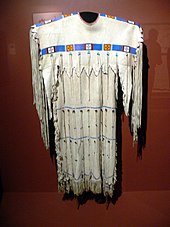
Back Cheyenne (volk) Afrikaans شايان (قبيلة) Arabic شايان ARZ Cheyenne BAR Шаены Byelorussian Шайени Bulgarian Xeiene Catalan Tsétsêhéstâhese CHY Šajeni Czech Cheyenne (indfødte amerikanere) Danish
| Total population | |
|---|---|
| 22,970 (Northern: 10,840;[1] Southern: 12,130[2]) | |
| Regions with significant populations | |
| United States (Montana, Oklahoma) | |
| Languages | |
| Cheyenne, English, Plains Sign Talk | |
| Religion | |
| Traditional tribal religion, Native American Church, and Christianity | |
| Related ethnic groups | |
| Arapaho, Blackfoot, Suhtai, and other Algonquian peoples |
The Cheyenne (/ʃaɪˈæn/ shy-AN) are an Indigenous people of the Great Plains. Their Cheyenne language belongs to the Algonquian language family. Today, the Cheyenne people are split into two federally recognized nations: the Southern Cheyenne, who are enrolled in the Cheyenne and Arapaho Tribes in Oklahoma, and the Northern Cheyenne, who are enrolled in the Northern Cheyenne Tribe of the Northern Cheyenne Indian Reservation in Montana.
The Cheyenne comprise two Native American tribes, the Só'taeo'o or Só'taétaneo'o (more commonly spelled as Suhtai or Sutaio) and the Tsétsêhéstâhese (also spelled Tsitsistas, [t͡sɪt͡shɪstʰɑs][3]). The tribes merged in the early 19th century.
At the time of their first European contact, the Cheyenne lived in what is now Minnesota. They were close allies of the Arapaho and loosely aligned with the Lakota. By the early 18th century, they were forced west by other tribes across the Missouri River and into North and South Dakota,[3] where they adopted the horse culture. Having settled the Black Hills of South Dakota and the Powder River Country of present-day Montana and Wyoming, they introduced the horse culture to Lakota people about 1730. With the Arapaho, the Cheyenne pushed the Kiowa to the Southern Plains. In turn, they were pushed west by the more numerous Lakota.[4]
The main group of Cheyenne, the Tsêhéstáno, was once composed of ten bands that spread across the Great Plains from southern Colorado to the Black Hills in South Dakota. They fought their historic enemies, the Crow and later (1856–79) the United States Army. In the mid-19th century, the bands began to split, with some bands choosing to remain near the Black Hills, while others chose to remain near the Platte Rivers of central Colorado.
The Northern Cheyenne, known in Cheyenne either as Notameohmésêhese, meaning "Northern Eaters" or simply as Ohmésêhese meaning "Eaters", live in southeastern Montana on the Northern Cheyenne Indian Reservation. Tribal enrollment figures, as of late 2014, indicate that there are approximately 10,840 members, of which about 4,939 reside on the reservation. Approximately 91% of the population are Native Americans (full or part race), with 72.8% identifying themselves as Cheyenne. Slightly more than one-quarter of the population five years or older spoke a language other than English.[5] The Southern Cheyenne, known in Cheyenne as Heévâhetaneo'o meaning "Roped People", together with the Southern Arapaho, form the Cheyenne and Arapaho Tribes, in western Oklahoma. Their combined population is 12,130, as of 2008[update].[2] In 2003, approximately 8,000 of these identified themselves as Cheyenne, although with continuing intermarriage it has become increasingly difficult to separate the tribes.[3]



- ^ "Northern Cheyenne Tribe website". Archived from the original on February 2, 2011. Retrieved November 11, 2013.
- ^ a b Oklahoma Indian Affairs. Oklahoma Indian Nations Pocket Pictorial Directory. Archived 2009-02-11 at the Wayback Machine 2008:7
- ^ a b c "Cheyenne, Southern." Archived 2009-02-28 at the Wayback Machine Oklahoma History Center's Encyclopedia of Oklahoma History and Culture. Retrieved 3 July 2013.
- ^ Walker, James R. & DeMallie, Raymond J. "Lakota Society" 1992.
- ^ "Northern Cheyenne Tribe website". Archived from the original on 2011-02-02. Retrieved 2009-02-22.